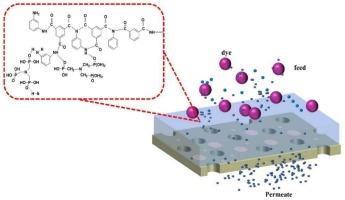水相界面聚合制备有机溶剂纳滤膜的研究
IF 9
1区 工程技术
Q1 ENGINEERING, CHEMICAL
引用次数: 0
摘要
本研究将几种膦酸添加剂整合到水相中,通过界面聚合制备有机溶剂纳滤膜。主要目的是研究不同浓度的氨基三亚甲基膦酸如何影响纳滤膜的分离效率。水相单体(MPD)中的氨基(NH2)基团与膦酸基团之间形成氢键,从而降低了MPD向有机相扩散的速度。这一过程导致形成较薄的聚酰胺(PA)活性层,从而增强了甲醇和其他纯溶剂的渗透性。此外,使用膦酸添加剂制备的纳滤膜表面粗糙度增强,导致聚酰胺团簇的增加。亲水性基团的加入增强了膜表面的亲水性,允许极性溶剂的快速移动。加入膦酸添加剂后,纳滤膜的溶剂渗透性有不同程度的增强。值得注意的是,甲醇的渗透率达到了12.5 L m−2 h−1 bar−1,而罗丹明B (RDB)染料的去除率保持在令人印象深刻的98.5% %。将维生素b12 -甲醇溶液连续过滤90 min,得到浓度为106倍的溶液(从20 mg/L到2125 mg/L)。本研究介绍了一种新的研究方法,用于开发针对有机溶剂优化的纳滤膜。本文章由计算机程序翻译,如有差异,请以英文原文为准。

Preparation of organic solvent nanofiltration membranes by interfacial polymerization with phosphonic acid additives in aqueous phase
In this research, several phosphonic acid additives were integrated into the aqueous phase to create organic solvent nanofiltration membranes through interfacial polymerization. The main objective was to examine how varying concentrations of aminotrimethylene phosphonic acid influence the separation efficiency of nanofiltration membranes. The hydrogen bonds were formed between the amino (NH2) groups in the aqueous-phase monomer (MPD) and the phosphonic acid group, which in turn reduced the rate at which MPD diffused into the organic phase. This process resulted in the formation of a thinner active layer of polyamide (PA), which enhanced the permeance of methanol and other pure solvents. Moreover, the nanofiltration membrane's surface, which was created using phosphonic acid additives, showed enhanced roughness, resulting in the development of elevated polyamide clusters. The addition of hydrophilic groups enhanced the membrane surface's hydrophilicity, allowing for the swift movement of polar solvents. The solvent permeance of nanofiltration membranes exhibited varying degrees of enhancement following the incorporation of phosphonic acid additives. Notably, the permeance for methanol achieved a value of 12.5 L m−2 h−1 bar−1, while the rejection rate for Rhodamine B (RDB) dyes remained at an impressive 98.5 %. The vitamin B12-methanol solution was continuously filtered for 90 min to obtain a 106 times concentrated solution (from 20 mg/L to 2125 mg/L). This study introduces a novel research methodology for the development of nanofiltration membranes optimized for organic solvents.
求助全文
通过发布文献求助,成功后即可免费获取论文全文。
去求助
来源期刊

Separation and Purification Technology
工程技术-工程:化工
CiteScore
14.00
自引率
12.80%
发文量
2347
审稿时长
43 days
期刊介绍:
Separation and Purification Technology is a premier journal committed to sharing innovative methods for separation and purification in chemical and environmental engineering, encompassing both homogeneous solutions and heterogeneous mixtures. Our scope includes the separation and/or purification of liquids, vapors, and gases, as well as carbon capture and separation techniques. However, it's important to note that methods solely intended for analytical purposes are not within the scope of the journal. Additionally, disciplines such as soil science, polymer science, and metallurgy fall outside the purview of Separation and Purification Technology. Join us in advancing the field of separation and purification methods for sustainable solutions in chemical and environmental engineering.
 求助内容:
求助内容: 应助结果提醒方式:
应助结果提醒方式:


